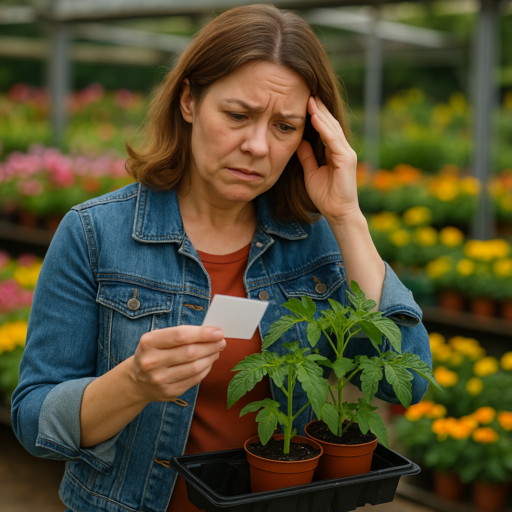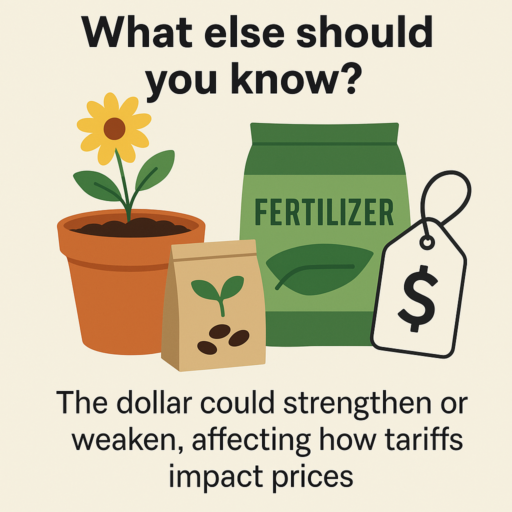
How did these tomatoes end up costing so much? Enough to give me telekinesis! (AI-generated)
Tariffs have been in the news a lot lately. As a home gardener, how much will it impact you?
Right now you probably won’t see much of a difference. Most seeds, cuttings, pots, soil mixes, and fertilizers for the 2025 spring season were already ordered before tariffs were enacted. You might see higher prices on soil mixes after your first frost-free date, so if you’re watching your budget it could make sense to stock up now.
If tariffs continue through the summer, expect price increases on fall offerings like bulbs, chrysanthemums, and cool-season vegetables.
If they’re still around by winter, many 2026 seed orders will be affected, and you’ll likely see noticeable price jumps on spring vegetable starts, ornamentals, and the supplies used to grow them.
Why will our prices go up if tariffs are imposed on other countries?
Well, there’s no guarantee that they will — but it’s very likely. Basically, the U.S. is charging other countries more money to bring their goods into the country. To maintain their profit margins, those suppliers will often raise their prices to offset the tariffs.
That means a U.S. distributor or grower will now be paying more than they used to for the same materials — at least until a less expensive alternative is found. Since they also need to make a profit, they’ll likely raise their prices as well.
Essentially, that cost increase gets passed along the entire supply chain — all the way to the end: you.
So what exactly comes from other countries?
| Pots and plastic trays | China and other Asian countries for low cost trays |
| Bulbs | Primarily the EU, Israel, and New Zealand |
| Seeds (non-open-pollinated heirlooms) | Netherlands, Chile, China, India, Thailand, the EU |
| Young plants and cuttings | Canada and Netherlands, Central America, Asia |
| Unrooted cuttings like geraniums and petunias | Central America, Mexico, China, Israel, Brazil, Ethiopia |
| Fertilizer | Canada, Trinidad, Morocco |
| Rockwool | Denmark, Netherlands, Germany, India, China |
| Sphagnum | Canada |
| Coco coir | Sri Lanka, India, Philippines, Mexico |
| Florist mums | Colombia, Ecuador |
The United States imports more than 50% of its seeds from other countries. If tariffs persist, we may see higher prices and fewer variety options.
Where do most US sellers source their seed stock?
| Netherlands | Hybrid vegetables, flowers, onions, bulbs |
| Italy | Tomatoes, chicories, beans, radicchio, |
| India | Eggplants, okra, cucurbits, carrots, tomatoes, peppers, melons |
| Thailand | Hot peppers, Asian vegetables |
| China | Brassicas, cucurbits, beans, Asian vegetables |
| Japan | High-end hybrid tomatoes, radishes, cucumbers, broccoli |
| Chile | Hybrid vegetable seeds such as sweet corn, cucurbits, tomato |

What’s still grown domestically?
- Open pollinated heirlooms from small farms and domestic seed savers
- Most corn seed
- Some beans, peas, and squash
- Many native plant seeds
These may become more prominent in future seasons if import prices continue to rise.
What else should you know?
While gardening for food may go up in price because of seed and supply costs, ornamentals from certain nurseries may not be hit as hard. Some nurseries source their stock from wholesalers who import materials from the countries listed above, but others — especially smaller mail-order nurseries — propagate plants directly from their own gardens. That means they might collect seed, take cuttings, divide plants, etc., so those particular plants wouldn’t be subject to tariffs.
That said, they’ll still be affected by rising prices on pots, fertilizers, and soil mixes. Less directly, over time, costs for things like irrigation and greenhouse supplies, tools, lighting, vehicle repairs, etc. will also indirectly increase the cost of raising plants.
There’s one last caveat: the economy is complicated. The actual impact of tariffs could shift depending on how the U.S. dollar performs against foreign currencies. If the dollar strengthens, tariffs may not increase prices much. But if it weakens, the added cost could be even more significant.




What are your sources for those stats? I’m not questioning their validity, but I like to know as a matter of principle.
That’s a good point.
There are many sources, and no single one covers them all. For example, when stating that unrooted geranium and petunia cuttings come from Central America and Africa, it’s based on reviewing supply chain details from major breeders and extrapolating from multiple reports.
The major suppliers of vegetative geraniums in the U.S. include Dümmen Orange, Syngenta Flowers, Ball FloraPlant, Selecta One, and a handful of others. To determine where the cuttings come from, you have to examine each company’s operations individually.
For instance, Dümmen Orange produces cuttings via stock plant production in Guatemala, Ethiopia, El Salvador, Colombia, and Kenya. Ball FloraPlant operates in Guatemala and Nicaragua. Syngenta Flowers sources from Kenya, Ethiopia, and Guatemala, while Selecta One produces in Kenya and Uganda.
Just confirming that required checking over a dozen different sources.
I’m going to try listing some of the more major sources. And thanks to your question, I discovered a mistake where I listed France as a major exporter of radishes, lettuce, and beets. They are, but not to the US. I’ve corrected the post.